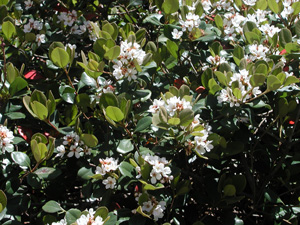Resource Library
Plant of the Week: Indian Hawthorn
The University of Arkansas System Division of Agriculture does not promote, support or recommend plants featured in "Plant of the Week." Please consult your local Extension office for plants suitable for your region.
Plant of the Week
Indian Hawthorn
Latin: Rhaphiolepis umbellata

My favorite ice cream shop has a drive up window and at every visit I’m surprised when I see a planting of Indian hawthorn (Rhaphiolepis umbellata) growing there. This landscape shrub of the lower South shouldn’t grow as far north as Fayetteville, but it has been there at least five years and has gone through at least one record breaking cold winter. What gives?
Indian hawthorn is an evergreen shrub belonging to the rose family which is native to China, Japan and Korea. It has the general form of flowering quince – but in an evergreen form – and makes a stoutly branched shrub 5 feet tall with a width greater than its height. It tolerates pruning well so is often seen as one of the ubiquitous little round balls of the contemporary landscape planting where it is often maintained at less than three feet in height.
The white flowered Rhaphiolepis umbellata is native in more temperate parts of Japan and Korea. The more southerly and freeze-tender R. indica, which has either white or pink flowers, was introduced into western gardens half a century earlier than the aforementioned species. These species have been hybridized and sometimes cultivars are listed under the name R. x delacourii.
Leaf shape and flower color are the main differentiating features between the two species. In R. umbellata the leathery leaves have either entire or rounded (crenate) margins while in R. indica the leaves have a serrate margin. In the former species the flowers are only white while in the more tender species flowers may be either white or pink. In surveying the more than three dozen cultivars in the nursery lists, pink-flowered selections predominate, indicating they have some of the more winter-tender R. indica in their linage.
The slightly fragrant five-petaled flowers are to.75- inch across and are produced in terminal clusters 3 or more inches across. They appear in the later part of spring after the dogwoods have bloomed and make a respectable if not outstanding display. A cluster of purple (or blue)-black berries to 3/8 inch in diameter are produced in late summer. Spontaneous seedlings have been reported as occurring in Clark County, Ark., presumably escapes from cultivated plantings.
Horticultural amnesia is a common affliction amongst nurserymen.
In the early 1980s Indian hawthorn was a “new plant” that swept through the nursery trade only to be devastated by back-to-back hard winters later in the decade. Plants froze back or were killed and a hardiness zone of zone 8 and south was established as the safe region for planting this shrub. However, because most production nurseries are located in zones 8 and 9, winters have been especially mild as global warming takes hold, and memories are short, Indian hawthorn has been creeping back into landscapes further north than history would tell us is safe. Realistically, most cultivars are probably hardy to about 5 degrees Fahrenheit, which corresponds to zone 7b.
The Indian hawthorn plants at my ice cream parlor are white flowered, indicating they have the more cold hardy R. umbellata in their background. Cold winters help nurserymen identify more cold tolerant selections so the clone growing here in Fayetteville is probably one of these.
The planting is also well sited on the south side of the building with a wall at their back and plenty of black top to radiate heat during cold snaps. Plants that are marginally hardy are best planted on the south side of a structure because the more shaded north side of a building usually is 5 to 10 degrees colder at night. And, though we did have a record cold snap in February of 2010, we also had a record snow so the plants were safely buried in nearly two feet of snow.
Indian hawthorn is hardy in all of Arkansas except for the higher elevation areas of the Ozark and Ouachita mountains. It is best in full sun but otherwise is tolerant of wide extremes of soil conditions and care. Once established it has good drought tolerance. It is a favorite deer browse plant and is susceptible to a leaf spot disease that can cause unsightly foliage or, in extreme conditions, defoliation.
By: Gerald Klingaman, retired
Retired Extension Horticulturist - Ornamentals
Extension News - October 5, 2012
The University of Arkansas System Division of Agriculture does not maintain lists of retail outlets where these plants can be purchased. Please check your local nursery or other retail outlets to ask about the availability of these plants for your growing area.